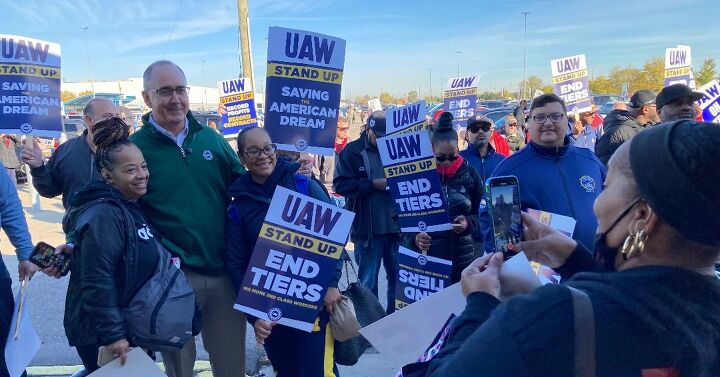
On Monday, United Auto Workers (UAW) members went on strike at Stellantis’s biggest assembly plant. The move is part of the union’s plan to gradually ramp up pressure against all three of the American-based automakers the UAW is presently in contract negotiations with.
We’ve recently seen the union targeting increasingly important facilities after talks appear to have stagnated. Less progress seems to have been made in recent weeks, with unions ramping up pressure and corporations hoping to sway public opinion via the media.
Action began on September 15th with the union announcing a “stand-up strike” that would see members called to walk out of targeted factories with very little notice. Automakers responded by laying off employees the following week, citing complications from work stoppages that were impacting supply lines.
Things have ramped up since then, with an estimated 40,000 union members working at Ford, General Motors, and Stellantis striking as additional plants were targeted. This represents over 25 percent of their entire workforce.
The latest action taken by the UAW pulled out 6,800 workers at the Michigan plant (owned by Stellantis) that’s responsible for the highly profitable RAM 1500 pickup. Union leadership said the facility had been targeted due to Stellantis having offered the “worst proposal” in regard to wage increases, cost-of-living adjustments, and the timeline required for employees to reach full-time status.
Hitting Stellantis’ Sterling Heights truck plant is highly reminiscent of the recent walkout seen at Ford’s Kentucky Truck assembly plant. These are the vehicles that matter most to those brands and shutting them down is a fairly serious escalation.
UAW President Shawn Fain has intentionally taken a more combative stance than his predecessors in an effort to restore workers’ benefits lost during the mid-2000s as part of the concessions designed to keep manufacturers from going bankrupt. However, both General Motors and Chrysler (now Stellantis) ended up taking government bailouts anyway.
Fain is likewise hoping to prove he’s not a pawn of the industry after a years-long court case proved a portion of the UAW’s former leadership was involved in a bribery scandal. He’s been emphatic that he’s not interested in cooperating with automakers or politicians if the end result doesn’t benefit American workers he claims have been taken advantage of for decades. While this originally seemed to endear him to the corporate media, he’s gotten less favorable coverage since telling politicians this isn’t their show to run.
A case in point is a recent article from the Associated Press suggesting that Fain’s demands may be out of whack with reality. The piece calls him “confrontational” while quoting anonymous automotive executives claiming they’re not sure whether the UAW actually has an end-game strategy. There’s also been a rash of speeches given by industry CEOs hinting that the UAW might push so hard that it jeopardizes the future of automotive employees.
That may end up being true. There’s certainly a limit to what the industry can endure in terms of the strike (which is the whole point of collective bargaining) and concessions will have to be made by at least one side if this battle is ever going to end. But this perspective seems to ignore how much money the industry has dumped into all-electric vehicles, autonomous driving systems, and other costly avenues that don’t appear to have yielded much in the way of profitability. It also sidesteps the broadening wage gap between staff and management during a period when companies were enjoying record-setting profits.
The UAW’s demands were chosen specifically to prove a point about how much executive compensation (and bonus pay) has exploded in recent decades as the wages of their core labor force haven’t even kept pace with inflation and benefits were walked back. We’ve covered this before. But it’s an important component in explaining why the UAW is taking such a hard stance against the industry right now.
The union has demanded a 40 percent wage hike over several years (including an immediate 20 percent increase), improved (or restored) employee benefits, and assurances that workers manufacturing EV batteries will likewise be covered under union agreements.
While automotive executives are publicly predicting economic doom if the union doesn’t relent, Fain has asked UAW members not to cave to the mounting pressure. He said that the corporate playbook is to stoke “fear, uncertainty, doubt and division” during contract negotiations — recommending that union members ignore those efforts. But he’s also suggested that talks may be nearing an end and a formal agreement could be reached soon.
[Image: UAW]
Become a TTAC insider. Get the latest news, features, TTAC takes, and everything else that gets to the truth about cars first by subscribing to our newsletter.

